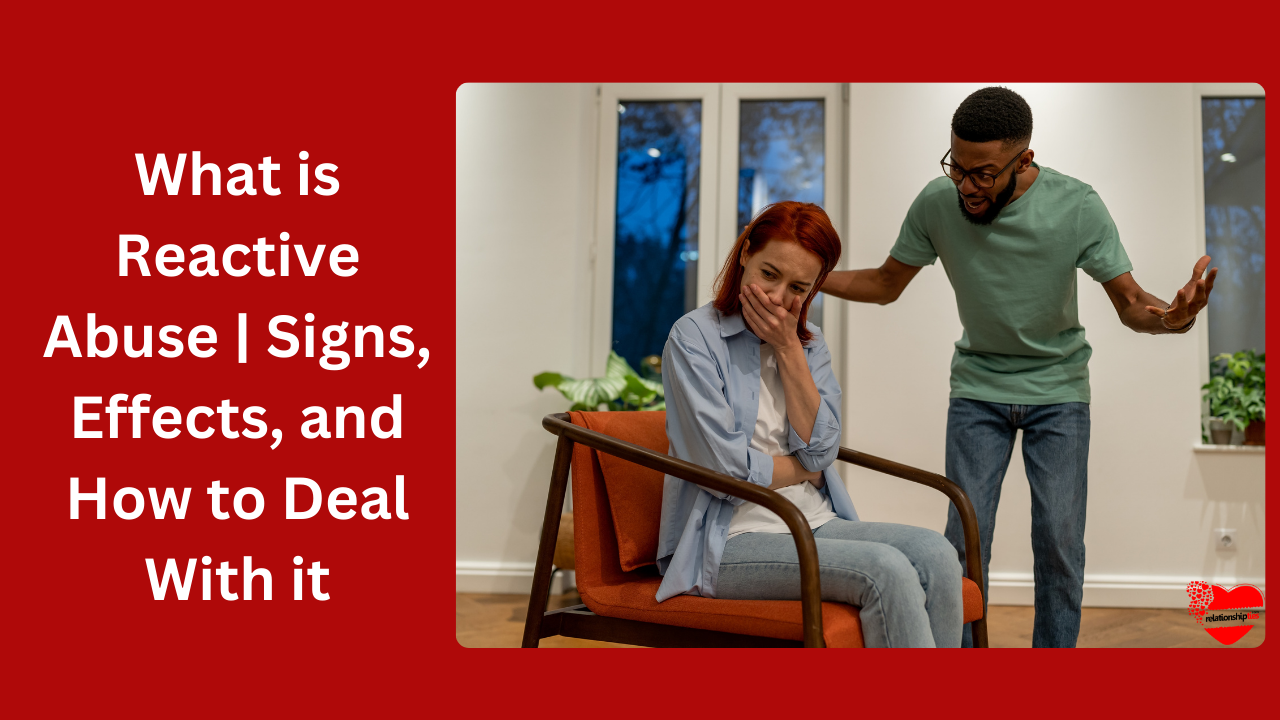In interpersonal relationships, reactive abuse is a complex dynamic that manifests as a reaction to persistent mistreatment, manipulation, or provocation.
It is characterised by cyclical behaviour in which a victim of long-term abuse responds defensively or violently, which frequently results in a series of escalating confrontations.
This reactive behaviour responds to long-lasting harm rather than an excuse for the initial abuse.
Breaking the cycle of damaging interactions and promoting better relationships requires an understanding of the indications, repercussions, and strategies for navigating reactive abuse.
Establishing environments that promote mutual respect and emotional well-being requires understanding the indicators of reactive abuse, recognising its effects, and utilising proactive measures to alleviate it.
This article throws more light on what reactive abuse means, its signs and effects, and how you can deal with it in a relationship. Understanding of this term can help you build A dynamic relationship.
What is Reactive Abuse?
Some abusers utilise reactive abuse, also known as DARVO (Deny, Attack, Reverse Victim and Offender), as a destructive and manipulative technique to silence and control their victims.
It happens when the victim of abuse responds to the abuse with intense feelings like anger, frustration, or other negative emotions.
The abuser then manipulates this reaction to make themselves appear the victim and divert attention from their own destructive actions.
According to CCADV, approximately 1 in 4 women (23.2%) and 1 in 7 men (13.9%) have been victims of severe physical violence due to an intimate partner. 1 in 2 women (47.1) and 1 in 2 men (47.3%) have experienced psychological assault by an intimate partner in their lives.
What are the Implications of Reactive Abuse?
Wide-ranging effects of reactive abuse can be seen in both persons and relationships:
1. Personal Effect:
- Emotional distress: low self-esteem, anxiety, sadness, PTSD, and confusion
- Difficulty trusting people
- Isolation and withdrawal
- Physical health issues
2. Effect on Relationships:
- Decreased communication and trust
- Enhanced conflict and tension
- Difficulty in problem-solving
- Growing power imbalance
- May result in the relationship ending
Knowing what constitutes reactive abuse allows people and communities to identify its deceptive strategies and take action to stop its negative effects.
Read ALSO: 15 Ways to Spot Toxic Relationships
What is the Difference Between Reactive Abuse and Mutual Abuse?
There are some significant distinctions between mutual abuse and reactive abuse, despite the fact that both include conflict in a relationship:
Defining Reactive Abuse:
Initiated Reaction:
When one partner reacts violently to ongoing abuse or mistreatment from the other, this is known as reactive abuse. It’s a protective response used to deter abuse or safeguard the individual.
Underlying Power Imbalance:
Reactive abuse is often accompanied by an underlying power imbalance in which one partner has greater influence and control over the other. This imbalance creates an environment where one partner feels justified in their abusive behaviour.
Restricted Range:
Reactive abuse is not a consistent pattern of behaviour; rather, it usually occurs under certain circumstances. After the event, the abusive partner could apologise or show regret for what they did.
Defensive Priorities:
Reactive abuse is primarily motivated by the need to defend oneself or get away from the abusive circumstance. The other partner is not to be controlled or subjected to pain.
Defining Mutual Abuse
Reciprocal and Cyclical:
When there is reciprocal abuse, both couples mistreat one another. As a result, there is a vicious cycle of escalation and conflict where both partners take pleasure in one other’s negativity.
Mechanical Power:
Even if there might occasionally be an imbalance of power, it can alternate between spouses in cases of mutual abuse. Abuse is something that both spouses are capable of doing and experiencing.
Statant Design:
Mutual abuse spreads beyond particular circumstances and takes on a dominant role in the partnership. There is little regret or attempt to alter the habitual behaviour.
It’s crucial to remember that determining the difference between mutual abuse and reactive abuse can be difficult and necessitates giving serious thought to the unique dynamics of each relationship.
Seeking professional assistance from a therapist or counsellor can be essential if you’re facing abuse in your relationship to comprehend the circumstances, establish appropriate limits, and create self-defence plans.
Here’s a table summarising the key differences between reactive abuse and mutual abuse:
| Feature | Reactive Abuse | Mutual Abuse |
| Trigger | Response to abuse | None |
| Power Imbalance | Yes | Yes, but can shift |
| Scope | Limited | Constant |
| Focus | Defense | Control |
| Intent | Self-protection | Domination |
Read Also: 25 Sure Ways on How to Fix a Relationship | Best Expert Tips
What are the Long-term Effects of Reactive Abuse?
Reactive abuse can have serious long-term effects that affect many facets of a person’s life. The following are some possible outcomes:
Mental:
- Post-traumatic stress disorder (PTSD): This condition, which is marked by flashbacks, nightmares, and avoidance behaviours, can be brought on by the ongoing stress and anxiety that come with reactive abuse.
- Depression and anxiety: The psychological damage caused by abuse can result in long-term depression and anxiety, which can impair mood, quality of sleep, and general well-being.
- Poor self-worth and self-esteem: Reactive abuse’s manipulative and controlling qualities can undermine a person’s self-esteem and cause them to feel unworthy.
- Trust issues: Being manipulated and betrayed might leave one feeling untrustworthy of people in subsequent relationships.
- Problems forming healthy relationships: Reactive abusive partnerships teach lessons that can affect future romantic and platonic relationships.
Social
- Social isolation: Withdrawal from loved ones, a lack of support system, and social isolation might result from the guilt and terror surrounding the abuse.
- Forming healthy partnerships is difficult: A skewed understanding of what constitutes a good connection might make building and preserving relationships with other people challenging.
Physical
- Chronic pain: Physical symptoms like headaches, stomachaches, and chronic pain can be a result of the stress and worry brought on by reactive abuse.
- Sleep issues: The emotional upheaval can cause sleep habits to be disturbed, which can result in exhaustion, sleeplessness, and trouble focusing.
- Substance abuse: Some people use drugs or alcohol as a coping method to deal with the trauma and agony they have experienced from abuse.
How Do I Recognize the Signs of Reactive Abuse?
Analysing relationship or interpersonal conflict behavioural patterns is necessary to spot reactive abuse indicators. These are a few signs that depict reactive abuse in a relationship:
1. Protective Conduct:
The individual may react violently to perceived or actual provocations, displaying protective behaviour. When someone feels assaulted or abused, they may react by becoming verbally aggressive, raising their voice, or showing outward signs of agitation.
2. Outbursts After Provocation:
Having a strong emotional or vocal reaction to someone else’s repeated abuse or provocation.
3. A Change in Conduct:
There could be a discernible change in behaviour, such as a move from composed or calm to defensive or reactive in reaction to particular stimuli or circumstances.
4. Pattern of Retaliation:
An ongoing tendency to respond defensively or angrily to mistreatment or abuse received from another individual.
5. Feeling Justified:
Despite the possibility that their reaction could be detrimental, they believe that their reactive conduct is justified in light of the maltreatment or abuse they have endured.
6. Sense of Guilt or uncertainty
Realising that their conduct, while reactive, might not have been the ideal response, leading to feelings of guilt or uncertainty after reactive episodes.
Understanding that, even though a response to mistreatment may be reactive, unhealthy behaviour is still unacceptable and must be acknowledged to identify the warning signals of reactive abuse.
To foster healthier interactions and relationships, it is imperative to address both the initial mistreatment and the reactionary behaviour.
Read ALSO: 15 Powerful Emotional Healing Techniques: How to Find Emotional Healing
Tips on How I Can deal with Reactive Abuse
Effective communication techniques and self-awareness are essential for handling reactive abuse. Here are some pointers:
Determine Triggers: Determine what sets off the reactive behaviour. You can better predict and control your reactions if you know what triggers these reactions.
Stop and Breathe: When you’re feeling agitated or mistreated, stop for a moment and relax. This can assist you in regaining your composure and avoiding a hasty decision.
Self-Reflection: Consider your feelings and responses. Addressing underlying difficulties can be facilitated by being aware of your emotions and the motivations behind your reactionary behaviour.
Seek Assistance: Consider obtaining assistance from a therapist or counsellor to address emotional triggers and acquire more effective coping skills.
Develop your forceful and courteous communication skills. Without using hostility or defensiveness, calmly and clearly express your feelings and worries.
Set Boundaries: In relationships, clearly define your boundaries. Be clear about the boundaries of acceptable and unacceptable behaviour and be assertive in upholding them.
Take Breaks: If you can, avoid the situation as tensions build. Taking a temporary backseat helps stop arguments from getting worse.
Take Care of Yourself: Take part in stress-relieving and relaxation-promoting activities. Taking good care of your mental and physical health might aid in managing reactive reactions.
Concentrate on Solutions: Rather than lingering on previous disagreements, concentrate on coming up with solutions and changing your behaviour and communication.
Be Willing to Learn and Adjust: Be willing to adapt and alter your automatic responses. Although changing one’s response requires time and work, even modest changes can have a big impact on how reactive abuse tendencies are handled.
Bottom Line
Reactive abuse is a complicated and frequently misinterpreted relationship that can have a big effect on someone’s mental and emotional health. To handle and prevent reactive abuse, it is important to recognise its warning signals, including defensiveness, blame-shifting, and intensifying confrontations.
To escape this destructive cycle, both the abuser and the victim must get professional assistance and support. People can learn to identify and deal with reactive abuse in relationships by encouraging open communication, exercising empathy, and setting appropriate boundaries.
Related Articles
- What is Sibling Sexual Abuse? | Facts, Signs, and Effects
- 16 Stages of a Dying Marriage: Understanding, Healing, and Moving Forward.”
- Top 15 Healthy Eating for Kids | Healthy Foods for Your Kids
- 15 Ways to Spot Toxic Relationships
- 25 Sure Ways on How to Fix a Relationship | Best Expert Tips
- 15 Powerful Emotional Healing Techniques: How to Find Emotional Healing






